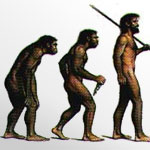A few times each month, I will post some random hair-related information, which I’m calling “tidbits”. I spend hours each day writing responses to questions I receive on this blog, so it is a nice change of pace. For example…

In an doctors email group that I subscribe to, some comments were made which I would like to share, as they will have value in understanding the hair loss process from an evolutionary point of view. I want you to know that the comments made by this group of doctors are not intended to start a debate on evolution – we will not relive the famous Scopes/Monkey trial on this blog. It was stimulated by the question: “How long have humans experienced hair loss?”
One doctor suggested that genetic hair loss must go back millions of years. Neanderthal men had hair loss with varying degrees of balding. Humans (in the evolutionary tree) developed in a different line from chimpanzees about 5-6 million years ago. Chimps have crown loss, which progresses over time as the male chimps get older. The hair loss in macaques, also with a similar mechanism, suggests the process was present in our cousins at least 15 million years ago.
We know that monkeys have been around for millions of years longer than homo sapiens. Was the stump-tail macaque always bald? My memory does not work that far back, but one of the doctors believed that the bald characteristic of the stump-tail macaque may have been more recent (I guess he has a better memory than I do). No one today knows what Neanderthal man looked like, although on the time scale discussed above, he was alive just 30,000 years ago. He left a lot of cave paintings of animals but no detailed self-portraits of his manly appearance, certainly not one of a balding cave man.
The group of doctors who share this information do so to disseminate more knowledge to each other. We try to become not only better doctors by helping each other, but also more knowledgeable ones, trying to help our patients who suffer from the pain of hair loss.

